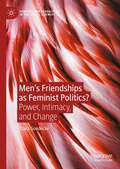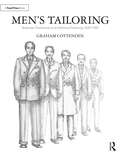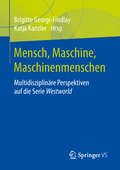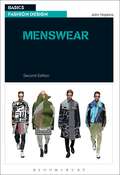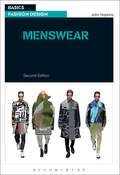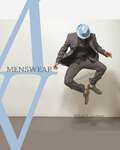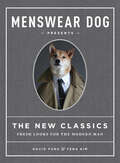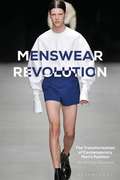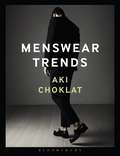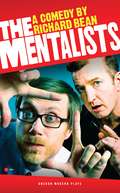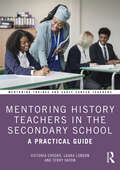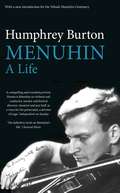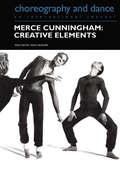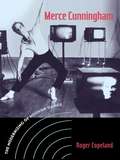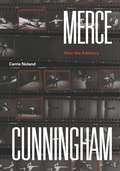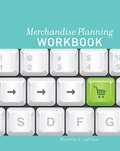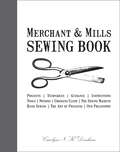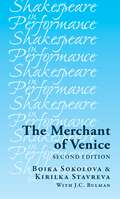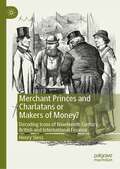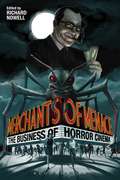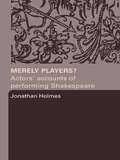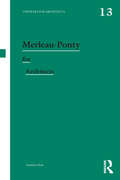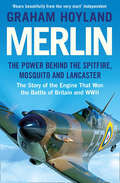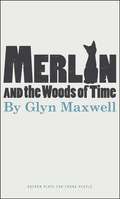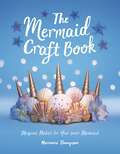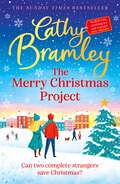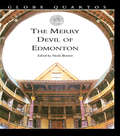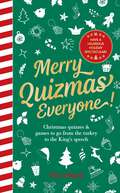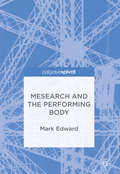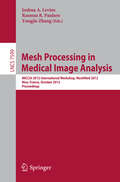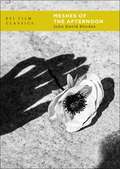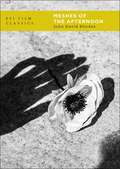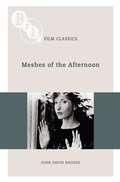- Table View
- List View
Men’s Friendships as Feminist Politics?: Power, Intimacy, and Change (Genders and Sexualities in the Social Sciences)
by Klara GoedeckeThis book discusses men’s friendships in relation to queer, discursive, and intersectional feminist theories. It analyses stories of intimacy, touch, hugs, and conversations, connecting these with current discussions within feminism and critical masculinity studies on “new” men, men’s political activism, and how friendships are lived and conceptualised in relation to heteronormative relationship ideals. Drawing on individual and dyadic interviews with middle-class Swedish men, all engaged in or sympathetic to feminist issues in some sense, this volume shows that Swedish gender equality ideologies as well as feminist, therapeutic, neo-liberal, and individualist discourses prevalent in the Western world structured the men’s friendships and their engagement with gender politics. Chapters cover friendship temporalities, gendered friendship ideals, friendship as men’s politics, and friendship as performed in interaction. Bridging the literatures of feminist research and friendship, the author points to tensions and contradictions in pro-feminist men’s political projects and in contemporary masculine positions.
Men's Tailoring: Bespoke, Theatrical and Historical Tailoring 1830-1950
by Graham CottendenMen’s Tailoring: Bespoke, Theatrical and Historical Tailoring 1830-1950 introduces the reader to English tailoring and covers the drafting of patterns, cutting out in cloth, and the complete traditional construction techniques in sequence for the tailoring of a waistcoat, trousers and jacket. The book contains: step-by-step instructions, complete with illustrations, for students and costumiers who are new to the making of male tailored garments from the nineteenth and twentieth centuries; drafting blocks and construction techniques for the main three styles of nineteenth century male garments: frock coat, morning coat and dress coat; patterns, photographs and detailed measurements taken from a variety of male coats, jackets, waistcoats and trousers from c1830 - c1950 from museums and collections. From choosing the right cloth to preparing for the fitting process, this how-to guide will help readers create beautiful, historically accurate three-piece suits for events and performances.
Men's Tailoring: Bespoke, Theatrical and Historical Tailoring 1830-1950
by Graham CottendenMen’s Tailoring: Bespoke, Theatrical and Historical Tailoring 1830-1950 introduces the reader to English tailoring and covers the drafting of patterns, cutting out in cloth, and the complete traditional construction techniques in sequence for the tailoring of a waistcoat, trousers and jacket. The book contains: step-by-step instructions, complete with illustrations, for students and costumiers who are new to the making of male tailored garments from the nineteenth and twentieth centuries; drafting blocks and construction techniques for the main three styles of nineteenth century male garments: frock coat, morning coat and dress coat; patterns, photographs and detailed measurements taken from a variety of male coats, jackets, waistcoats and trousers from c1830 - c1950 from museums and collections. From choosing the right cloth to preparing for the fitting process, this how-to guide will help readers create beautiful, historically accurate three-piece suits for events and performances.
Mensch, Maschine, Maschinenmenschen: Multidisziplinäre Perspektiven auf die Serie Westworld
by Brigitte Georgi-Findlay Katja KanzlerDieses Buch setzt sich mit der viel diskutierten HBO-Serie Westworld auseinander. Aus multidisziplinären Perspektiven fragen die Autor*innen danach, wie die Science-Fiction/Western-Serie als Erzählung funktioniert und dabei Aspekte des Posthumanismus, Fragen künstlicher Intelligenz und das Verhältnis von Mensch und Maschine problematisiert.
Menswear (Basics Fashion Design)
by John HopkinsMenswear books for fashion design students are under-represented when compared to womenswear titles, and are often divided into historical surveys of menswear and technical pattern cutting books. Basics Fashion Design 07: Menswear provides a broad introduction to menswear by considering a range of social and historical contexts that have served to define and redefine this fascinating area of fashion through the ages, and also includes interviews with contemporary menswear labels, stylists and designers.These interviews provide valuable insights into the different styles and role models who continue to influence and define menswear in the twenty-first century.This colorful and varied book provides details on both the design process and sources of research for menswear. All topics are considered and presented in context with fashion drawings and presentation formats - from students and recent graduates as well as more established design labels.
Menswear (Basics Fashion Design Ser.)
by John HopkinsWhether it's a military inspired trench coat or a Savile Row tailored suit, menswear design increasingly demands originality, innovation and above all, choice. Menswear, 2nd edition explores the evolution of menswear styles, from the origins of tailoring right through to modern sportswear – showing how historical and social influencescontinue to endure and influence the menswear collections of today.Interviews offer insight from a range of practitioners, including designer Lou Dalton, fashion entrepreneur Alan Maleh and tailor Ray Stowers. There's also practical advice on research for design innovation, street style, trends and forecasting and collection development. With a wealth of stunning new images and contemporary examples, new to this edition are end-of-chapter exercises to encourage design work, such as Design for Sportswear Fabrication and Tailoring for Menswear. Featured topicsHistorical Research for Design InnovationCounterculture DressingDesign ProcessStreet StyleTrends and ForecastingTailoring for MenswearCollection DevelopmentDrawing for MenCAD for MenswearMenswear PortfoliosFeatured intervieweesLou DaltonGuy Hill and Kirsty McDougall,Dashing TweedsAlan Maleh, Man of the WorldRay Stowers, Stowers BespokeSeung Won Hong, Fashion IllustratorMatthew Zorpas, The Gentleman Blogger
Menswear: Business to Style
by Michael LondriganMenswear: Business to Style explores the historical beginnings of menswear, setting the stage for today's diverse and exciting industry and preparing students to assume a role in the business as it continues to evolve. Drawing on his experiences in menswear, the author discusses design and manufacturing in four main areas: tailored clothing, furnishings, formal wear, and sportswear. The text also covers the principles, procedures, and techniques merchandisers employ to attract their target customers, giving the reader an appreciation of menswear from both a fashion and economic standpoint.
Menswear Dog Presents the New Classics: Fresh Looks for the Modern Man
by David Fung Yena KimBodhi, the Shiba Inu behind the beloved blog Menswear Dog, is here to show you how to dress like a man. Organized seasonally, The New Classics highlights the timeless, can&’t-go-wrong items every man needs in his wardrobe—from a chambray shirt to a perfectly fitted peacoat (all modeled by Bodhi, of course)—and shows how to mix and match them all year long. Whatever your style dilemma, dog&’s got your back! Readers will learn what to wear to a summer wedding, when to splurge (on the perfect white dress shirt) and when to save (snag your military field jacket at a thrift store), the secrets to getting the right fit, the brands that stand the test of time, the basics of clothing care, and more.
Menswear Revolution: The Transformation of Contemporary Men’s Fashion
by Jay McCauley BowsteadIn recent years, menswear has moved decisively center stage. Menswear Revolution investigates the transformation of men's fashion through the lens of shifting masculinities, examining how its increasing diversity has created new ways for men to explore and express their identities. Harnessing sustained market growth and creative dynamism on the runway, ground-breaking designers from Raf Simons and Hedi Slimane to Craig Green have revolutionized the discipline with their bold re-imaginings of the male wardrobe.Analysing the role of the media in shaping attitudes to men's fashion, Menswear Revolution studies how competing narratives of masculinity are reflected in popular discourse. Taking us from the mod and peacock revolutions of the 1960s to the new wave aesthetics of the 1980s, the book explores historical precedents for today's menswear scene – and looks at the evolution of the 'ideal' male body, from the muscular to the lean and boyish. Combining interviews with fashion professionals with close analyses of garments and advertising, Menswear Revolution provides an authoritative account of menswear design today. Highlighting its relationship to changing concepts of gender, the book provides a much-needed update to scholarship on masculinity, fashion and the body.
Menswear Revolution: The Transformation of Contemporary Men’s Fashion
by Jay McCauley BowsteadIn recent years, menswear has moved decisively center stage. Menswear Revolution investigates the transformation of men's fashion through the lens of shifting masculinities, examining how its increasing diversity has created new ways for men to explore and express their identities. Harnessing sustained market growth and creative dynamism on the runway, ground-breaking designers from Raf Simons and Hedi Slimane to Craig Green have revolutionized the discipline with their bold re-imaginings of the male wardrobe.Analysing the role of the media in shaping attitudes to men's fashion, Menswear Revolution studies how competing narratives of masculinity are reflected in popular discourse. Taking us from the mod and peacock revolutions of the 1960s to the new wave aesthetics of the 1980s, the book explores historical precedents for today's menswear scene – and looks at the evolution of the 'ideal' male body, from the muscular to the lean and boyish. Combining interviews with fashion professionals with close analyses of garments and advertising, Menswear Revolution provides an authoritative account of menswear design today. Highlighting its relationship to changing concepts of gender, the book provides a much-needed update to scholarship on masculinity, fashion and the body.
Menswear Trends (Required Reading Range)
by Aki ChoklatMenswear Trends will help you understand the relationship of menswear to society, enabling you to become both a forecaster and trend thinker – and bring new ideas, innovation and strategies to men's fashion. With designer and educator Aki Choklat you'll learn how menswear trends fit within the larger context of retail, how brands can use trends to be more competitive, and how to create an inspiring trend forecast. Later chapters show how to analyse catwalks, gather information from street-style coverage, compare short-term and long-term analysis and how to analyse and forecast colour trends. In the final chapter you'll explore the various job roles within the trend industry, learn to differentiate between trend services and how to navigate the contemporary job market and illustrate your skills in a portfolio.Industry Insight Interviews:Peter Betsche, CEO, ArvencoDavid Edgar, one of the founding partners of Bureaux Design Associates (BDA)Michael Fisher, Creative Director – Menswear, Fashion SnoopsJaana Jätyri, founder of TrendstopVolker Ketteniss, Head of Menswear, WGSNSandy MacLennan, founder of East Central StudiosEmber Todd Colour and Trend Manager for Chaco Brand, Wolverine Worldwide Barbara Vinken, Chair of Comparative and French Literature, University of MunichGeraldine Wharry, founder of Trend Atelier
Menswear Trends (Required Reading Range)
by Aki ChoklatMenswear Trends will help you understand the relationship of menswear to society, enabling you to become both a forecaster and trend thinker – and bring new ideas, innovation and strategies to men's fashion. With designer and educator Aki Choklat you'll learn how menswear trends fit within the larger context of retail, how brands can use trends to be more competitive, and how to create an inspiring trend forecast. Later chapters show how to analyse catwalks, gather information from street-style coverage, compare short-term and long-term analysis and how to analyse and forecast colour trends. In the final chapter you'll explore the various job roles within the trend industry, learn to differentiate between trend services and how to navigate the contemporary job market and illustrate your skills in a portfolio.Industry Insight Interviews:Peter Betsche, CEO, ArvencoDavid Edgar, one of the founding partners of Bureaux Design Associates (BDA)Michael Fisher, Creative Director – Menswear, Fashion SnoopsJaana Jätyri, founder of TrendstopVolker Ketteniss, Head of Menswear, WGSNSandy MacLennan, founder of East Central StudiosEmber Todd Colour and Trend Manager for Chaco Brand, Wolverine Worldwide Barbara Vinken, Chair of Comparative and French Literature, University of MunichGeraldine Wharry, founder of Trend Atelier
The Mentalists: The Mentalists - Under The Whaleback - The God Botherers (Modern Playwrights Ser.)
by Richard BeanA hotel room, a long-standing friendship and a hair raising plan! Holed up in a faceless Finsbury Park hotel room, Ted and Morrie are forced to confront the darker side of their unique relationship. Things unravel as the pressure mounts in this hilarious and touching tale of friendship and utopian visions gone awry.
Mentoring History Teachers in the Secondary School: A Practical Guide (Mentoring Trainee and Early Career Teachers)
by Victoria Crooks Laura London Terry HaydnMentoring History Teachers in the Secondary School supports mentors to develop the knowledge, skills and understanding essential to the successful mentoring of beginning history teachers who are undertaking their initial teacher training or being inducted into the profession as early career teachers. The authors critically explore models of mentoring and place subject specificity at the heart of every chapter, offering practical mentoring strategies rooted in the best evidence and research from the history teaching community. This book is a vital source of encouragement and inspiration for all those involved in developing the next generation of history teachers, providing accessible summaries of history-specific thinking on a range of topics alongside mentoring support. Key topics include: • Understanding what being a subject-specific mentor of beginning history teachers involves. • Establishing a dialogic mentor-mentee relationship. • Supporting beginning teachers to develop the substantive and disciplinary knowledge they need to become excellent history teachers. • Guiding beginning history teachers through the lesson planning process. • Conducting subject-specific lesson observations and pre- and post-lesson discussions. • Supporting beginning history teachers to consider the purpose of history education and how they can navigate this in relation to values education, the use of ICT, and the teaching of controversial and sensitive issues. Mentoring History Teachers in the Secondary School offers an accessible and practical guide to mentoring beginning history teachers, with ready-to-use strategies to support and inspire both mentors and beginning teachers alike.
Mentoring History Teachers in the Secondary School: A Practical Guide (Mentoring Trainee and Early Career Teachers)
by Victoria Crooks Laura London Terry HaydnMentoring History Teachers in the Secondary School supports mentors to develop the knowledge, skills and understanding essential to the successful mentoring of beginning history teachers who are undertaking their initial teacher training or being inducted into the profession as early career teachers. The authors critically explore models of mentoring and place subject specificity at the heart of every chapter, offering practical mentoring strategies rooted in the best evidence and research from the history teaching community. This book is a vital source of encouragement and inspiration for all those involved in developing the next generation of history teachers, providing accessible summaries of history-specific thinking on a range of topics alongside mentoring support. Key topics include: • Understanding what being a subject-specific mentor of beginning history teachers involves. • Establishing a dialogic mentor-mentee relationship. • Supporting beginning teachers to develop the substantive and disciplinary knowledge they need to become excellent history teachers. • Guiding beginning history teachers through the lesson planning process. • Conducting subject-specific lesson observations and pre- and post-lesson discussions. • Supporting beginning history teachers to consider the purpose of history education and how they can navigate this in relation to values education, the use of ICT, and the teaching of controversial and sensitive issues. Mentoring History Teachers in the Secondary School offers an accessible and practical guide to mentoring beginning history teachers, with ready-to-use strategies to support and inspire both mentors and beginning teachers alike.
Menuhin: A Life
by Sir Humphrey BurtonSince 2000, when this biography was first published, Menuhin's name has not faded from public attention, as often happens in the decades after the death of a popular performing artist. Far from it: the centenary of his birth, April 22, 1916, is being marked by celebrations around the world.Yehudi Menuhin was born in New York of Russian Jewish immigrants. Prodigiously gifted, the 'Miracle Boy' gave his first solo recital aged eight and within five years was world-famous. Menuhin was a visionary individualist, who didn't mind shocking the establishment. His post-war support for the conductor Wilhelm Furtwängler, and his determination to build bridges with the defeated German nation, brought him into sharp conflict with the Jewish establishment and DPs in Berlin. Later he spoke out against apartheid in South Africa and denounced the Soviet Union's oppressive policy towards writers and dissidents.Drawing on contemporary sources, unpublished family correspondence and radio interviews, Burton creates a compelling portrait of an extraordinary human being - one of the best-loved classical musicians of the twentieth century.
Merce Cunningham: Creative Elements (Choreography and Dance Studies Series #Vols. 4, Pts. 2.)
by Joan Acocella Elliot Caplan Marilyn Vaughan Drown William Fetterman John Holzaepfel Gordon Mumma Nelson Rivera Thecla Schiphorst David VaughanMerce Cunningham reached the age of 75 in 1994, an age at which many creative artists are content to rest on their laurels, or at least to leave behind whatever controversies they may have caused during their careers. No so Cunningham. In the first place, his 70s have been a time of intense creativity in which he has choreographed as many as four new works a year. Cunningham is a strongly committed as ever to the discovery of new ways of moving and of making movement, refusing to be hampered by the physical limitations that have come with age. Since 1991 every new work has been made at least in part with the use of the computer program Life Forms, which enables him to devise choreographic phrases that he himself would be unable to perform - and which challenge and develop the virtuosity of the young dancers in his company.The essays collected in this special issue of Choreography and Dance were written over the last few years and discuss various aspects of the work of Cunningham as seen both from the outside and the inside.
Merce Cunningham: The Modernizing of Modern Dance
by Roger CopelandFirst Published in 2004. Routledge is an imprint of Taylor & Francis, an informa company.
Merce Cunningham: The Modernizing of Modern Dance
by Roger CopelandFirst Published in 2004. Routledge is an imprint of Taylor & Francis, an informa company.
Merce Cunningham: After the Arbitrary
by Carrie NolandOne of the most influential choreographers of the twentieth century, Merce Cunningham is known for introducing chance to dance. Far too often, however, accounts of Cunningham’s work have neglected its full scope, focusing on his collaborations with the visionary composer John Cage or insisting that randomness was the singular goal of his choreography. In this book, the first dedicated to the complete arc of Cunningham’s career, Carrie Noland brings new insight to this transformative artist’s philosophy and work, providing a fresh perspective on his artistic process while exploring aspects of his choreographic practice never studied before. Examining a rich and previously unseen archive that includes photographs, film footage, and unpublished writing by Cunningham, Noland counters prior understandings of Cunningham’s influential embrace of the unintended, demonstrating that Cunningham in fact set limits on the role chance played in his dances. Drawing on Cunningham’s written and performed work, Noland reveals that Cunningham introduced variables before the chance procedure was applied and later shaped and modified the chance results. Chapters explore his relation not only to Cage, but also Marcel Duchamp, Robert Rauschenberg, James Joyce, and Bill T. Jones. Ultimately, Noland shows that Cunningham approached movement as more than “movement in itself,” and that his work enacted archetypal human dramas. This remarkable book will forever change our appreciation of the choreographer’s work and legacy.
Merce Cunningham: After the Arbitrary
by Carrie NolandOne of the most influential choreographers of the twentieth century, Merce Cunningham is known for introducing chance to dance. Far too often, however, accounts of Cunningham’s work have neglected its full scope, focusing on his collaborations with the visionary composer John Cage or insisting that randomness was the singular goal of his choreography. In this book, the first dedicated to the complete arc of Cunningham’s career, Carrie Noland brings new insight to this transformative artist’s philosophy and work, providing a fresh perspective on his artistic process while exploring aspects of his choreographic practice never studied before. Examining a rich and previously unseen archive that includes photographs, film footage, and unpublished writing by Cunningham, Noland counters prior understandings of Cunningham’s influential embrace of the unintended, demonstrating that Cunningham in fact set limits on the role chance played in his dances. Drawing on Cunningham’s written and performed work, Noland reveals that Cunningham introduced variables before the chance procedure was applied and later shaped and modified the chance results. Chapters explore his relation not only to Cage, but also Marcel Duchamp, Robert Rauschenberg, James Joyce, and Bill T. Jones. Ultimately, Noland shows that Cunningham approached movement as more than “movement in itself,” and that his work enacted archetypal human dramas. This remarkable book will forever change our appreciation of the choreographer’s work and legacy.
Merce Cunningham: After the Arbitrary
by Carrie NolandOne of the most influential choreographers of the twentieth century, Merce Cunningham is known for introducing chance to dance. Far too often, however, accounts of Cunningham’s work have neglected its full scope, focusing on his collaborations with the visionary composer John Cage or insisting that randomness was the singular goal of his choreography. In this book, the first dedicated to the complete arc of Cunningham’s career, Carrie Noland brings new insight to this transformative artist’s philosophy and work, providing a fresh perspective on his artistic process while exploring aspects of his choreographic practice never studied before. Examining a rich and previously unseen archive that includes photographs, film footage, and unpublished writing by Cunningham, Noland counters prior understandings of Cunningham’s influential embrace of the unintended, demonstrating that Cunningham in fact set limits on the role chance played in his dances. Drawing on Cunningham’s written and performed work, Noland reveals that Cunningham introduced variables before the chance procedure was applied and later shaped and modified the chance results. Chapters explore his relation not only to Cage, but also Marcel Duchamp, Robert Rauschenberg, James Joyce, and Bill T. Jones. Ultimately, Noland shows that Cunningham approached movement as more than “movement in itself,” and that his work enacted archetypal human dramas. This remarkable book will forever change our appreciation of the choreographer’s work and legacy.
Merce Cunningham: After the Arbitrary
by Carrie NolandOne of the most influential choreographers of the twentieth century, Merce Cunningham is known for introducing chance to dance. Far too often, however, accounts of Cunningham’s work have neglected its full scope, focusing on his collaborations with the visionary composer John Cage or insisting that randomness was the singular goal of his choreography. In this book, the first dedicated to the complete arc of Cunningham’s career, Carrie Noland brings new insight to this transformative artist’s philosophy and work, providing a fresh perspective on his artistic process while exploring aspects of his choreographic practice never studied before. Examining a rich and previously unseen archive that includes photographs, film footage, and unpublished writing by Cunningham, Noland counters prior understandings of Cunningham’s influential embrace of the unintended, demonstrating that Cunningham in fact set limits on the role chance played in his dances. Drawing on Cunningham’s written and performed work, Noland reveals that Cunningham introduced variables before the chance procedure was applied and later shaped and modified the chance results. Chapters explore his relation not only to Cage, but also Marcel Duchamp, Robert Rauschenberg, James Joyce, and Bill T. Jones. Ultimately, Noland shows that Cunningham approached movement as more than “movement in itself,” and that his work enacted archetypal human dramas. This remarkable book will forever change our appreciation of the choreographer’s work and legacy.
Merce Cunningham: After the Arbitrary
by Carrie NolandOne of the most influential choreographers of the twentieth century, Merce Cunningham is known for introducing chance to dance. Far too often, however, accounts of Cunningham’s work have neglected its full scope, focusing on his collaborations with the visionary composer John Cage or insisting that randomness was the singular goal of his choreography. In this book, the first dedicated to the complete arc of Cunningham’s career, Carrie Noland brings new insight to this transformative artist’s philosophy and work, providing a fresh perspective on his artistic process while exploring aspects of his choreographic practice never studied before. Examining a rich and previously unseen archive that includes photographs, film footage, and unpublished writing by Cunningham, Noland counters prior understandings of Cunningham’s influential embrace of the unintended, demonstrating that Cunningham in fact set limits on the role chance played in his dances. Drawing on Cunningham’s written and performed work, Noland reveals that Cunningham introduced variables before the chance procedure was applied and later shaped and modified the chance results. Chapters explore his relation not only to Cage, but also Marcel Duchamp, Robert Rauschenberg, James Joyce, and Bill T. Jones. Ultimately, Noland shows that Cunningham approached movement as more than “movement in itself,” and that his work enacted archetypal human dramas. This remarkable book will forever change our appreciation of the choreographer’s work and legacy.
Merce Cunningham: After the Arbitrary
by Carrie NolandOne of the most influential choreographers of the twentieth century, Merce Cunningham is known for introducing chance to dance. Far too often, however, accounts of Cunningham’s work have neglected its full scope, focusing on his collaborations with the visionary composer John Cage or insisting that randomness was the singular goal of his choreography. In this book, the first dedicated to the complete arc of Cunningham’s career, Carrie Noland brings new insight to this transformative artist’s philosophy and work, providing a fresh perspective on his artistic process while exploring aspects of his choreographic practice never studied before. Examining a rich and previously unseen archive that includes photographs, film footage, and unpublished writing by Cunningham, Noland counters prior understandings of Cunningham’s influential embrace of the unintended, demonstrating that Cunningham in fact set limits on the role chance played in his dances. Drawing on Cunningham’s written and performed work, Noland reveals that Cunningham introduced variables before the chance procedure was applied and later shaped and modified the chance results. Chapters explore his relation not only to Cage, but also Marcel Duchamp, Robert Rauschenberg, James Joyce, and Bill T. Jones. Ultimately, Noland shows that Cunningham approached movement as more than “movement in itself,” and that his work enacted archetypal human dramas. This remarkable book will forever change our appreciation of the choreographer’s work and legacy.
Merce Cunningham: Creative Elements (Choreography and Dance Studies Series)
by David VaughanMerce Cunningham reached the age of 75 in 1994, an age at which many creative artists are content to rest on their laurels, or at least to leave behind whatever controversies they may have caused during their careers. No so Cunningham. In the first place, his 70s have been a time of intense creativity in which he has choreographed as many as four new works a year. Cunningham is a strongly committed as ever to the discovery of new ways of moving and of making movement, refusing to be hampered by the physical limitations that have come with age. Since 1991 every new work has been made at least in part with the use of the computer program Life Forms, which enables him to devise choreographic phrases that he himself would be unable to perform - and which challenge and develop the virtuosity of the young dancers in his company.The essays collected in this special issue of Choreography and Dance were written over the last few years and discuss various aspects of the work of Cunningham as seen both from the outside and the inside.
Merchandise Buying and Management
by John DonnellanThe fourth edition of Merchandise Buying and Management has been updated to cover the most current information on merchandising and retailing. Written for college-level courses dealing with retail buying and the management for retail inventories, the text covers topics relevant to future buyers and store management personnel. The material is presented within the context of a contemporary retail environment-with examples from both fashion and non-fashion retailers-in which buyers often act as fiscal managers as well as product developers, and store managers play important roles in sales productivity and assortment planning. Retail technology is a theme that runs throughout the book, tied to topics such as space management, electronic data exchange, point-of-sale systems, and floor ready merchandise.
Merchandise Planning Workbook: - with STUDIO
by Rosetta LaFleurThe recipe for profitability is presented in Merchandise Planning Workbook. Focusing on the development of a six-month merchandise plan, the text explains how to use Excel 2007 as a tool to project sales, manage inventory, calculate the amount of merchandise to purchase, and adjust the price throughout the selling season. Application Exercises throughout the chapters familiarize students with each aspect of the plan, provide practice in inputting formulas and data, and demonstrate the impact of changing variables. Seven end-of-chapter assignments, when completed in sequence, produce a merchandise plan for a selling season. By mastering this important aspect of merchandising math, students can develop a marketable competency to help launch their careers in retailing.PLEASE NOTE: Purchasing or renting this ISBN does not include access to the STUDIO resources that accompany this text. To receive free access to the STUDIO content with new copies of this book, please refer to the book + STUDIO access card bundle ISBN 9781501395567. STUDIO Instant Access can also be purchased or rented separately on BloomsburyFashionCentral.com.
Merchant & Mills Sewing Book
by Carolyn Denham Roderick FieldKeep it simple and do it well. The Merchant & Mills Sewing Book contains fifteen step-by-step projects aimed at guiding you gently but firmly through the basics of sewing.
The Merchant of Venice: Second edition (Shakespeare in Performance)
by Boika Sokolova Kirilka StavrevaBoika Sokolova and Kirilka Stavreva’s second edition of the stage history of The Merchant of Venice interweaves into the chronology of James Bulman’s first edition richly contextualised chapters on Max Reinhardt, Peter Zadek, and the first production of the play in Mandatory Palestine, directed by Leopold Jessner. While the focus of the book is on post-1990s productions across Europe and the USA, and on film, the Segue provides a broad survey of the interpretative shifts in the play’s performance from the 1930s to the second decade of the twenty-first century. Individual chapters explore productions by Peter Zadek, Trevor Nunn, Robert Sturua, Edward Hall, Rupert Goold, Daniel Sullivan, and Karin Coonrod. An extensive film section including silent film offers close analysis of Don Selwyn’s Te Tangata Whai Rawa o Weniti and Michael Radford’s adaptation. Accessible and engaging, the book will interest students, academics, and general readers.
The Merchant of Venice: Second edition (Shakespeare in Performance)
by Boika Sokolova Kirilka StavrevaBoika Sokolova and Kirilka Stavreva’s second edition of the stage history of The Merchant of Venice interweaves into the chronology of James Bulman’s first edition richly contextualised chapters on Max Reinhardt, Peter Zadek, and the first production of the play in Mandatory Palestine, directed by Leopold Jessner. While the focus of the book is on post-1990s productions across Europe and the USA, and on film, the Segue provides a broad survey of the interpretative shifts in the play’s performance from the 1930s to the second decade of the twenty-first century. Individual chapters explore productions by Peter Zadek, Trevor Nunn, Robert Sturua, Edward Hall, Rupert Goold, Daniel Sullivan, and Karin Coonrod. An extensive film section including silent film offers close analysis of Don Selwyn’s Te Tangata Whai Rawa o Weniti and Michael Radford’s adaptation. Accessible and engaging, the book will interest students, academics, and general readers.
Merchant Princes and Charlatans or Makers of Money?: Decoding Icons of Nineteenth Century British and International Finance
by Henry SlessThis book provides a critical analysis of visual images of British and international finance during the nineteenth century. Its focus is on the financiers themselves, contrasting the depiction of the respectable Merchant Princes with the less than perfect charlatans (white-collar criminals) who defrauded investors of millions. The breakdown of trust between financiers and investors that evolved during this period is represented visually in depictions of the emotional response of investors to the uncertain financial climate.Throughout the book a PEARL methodology has been used to critique the images reflecting the impact of any Publisher’s political bias, the Editorial and Artistic techniques used to convey the messages in the images, and the Legal context (especially a concern in countries such as France and Germany where censorship was strict).The book concludes that white-collar criminals were invariably secretly admired in Britain, and rarely severely satirised. Similarly, Merchant Princes were depicted favourably in Britain as members of the ruling elite during the latter half of the century. This is contrasted with the more extreme anti-monopolistic images in the US and the extreme anti-Semitic treatment of Jewish financiers in France and Germany.
Merchants of Menace: The Business of Horror Cinema
by Richard NowellEven though horror has been a key component of media output for almost a century, the genre's industrial character remains under explored and poorly understood. Merchants of Menace: The Business of Horror Cinema responds to a major void in film history by shedding much-needed new light on the economic dimensions of one of the world's most enduring audiovisual forms. Given horror cuts across budgetary categories, industry sectors, national film cultures, and media, Merchants of Menace also promises to expand understandings of the economics of cinema generally. Covering 1930-present, this groundbreaking collection boasts fourteen original chapters from world-leading experts taking as their focus such diverse topics as early zombie pictures, post-WWII chillers, Civil Rights-Era marketing, Hollywood literary adaptations, Australian exploitation, "torture-porn" Auteurs, and twenty-first-century remakes.
Merchants of Menace: The Business of Horror Cinema
by Richard NowellEven though horror has been a key component of media output for almost a century, the genre's industrial character remains under explored and poorly understood. Merchants of Menace: The Business of Horror Cinema responds to a major void in film history by shedding much-needed new light on the economic dimensions of one of the world's most enduring audiovisual forms. Given horror cuts across budgetary categories, industry sectors, national film cultures, and media, Merchants of Menace also promises to expand understandings of the economics of cinema generally. Covering 1930-present, this groundbreaking collection boasts fourteen original chapters from world-leading experts taking as their focus such diverse topics as early zombie pictures, post-WWII chillers, Civil Rights-Era marketing, Hollywood literary adaptations, Australian exploitation, "torture-porn" Auteurs, and twenty-first-century remakes.
Merely Players?: Actors' Accounts of Performing Shakespeare
by Jonathan HolmesMerely Players? marks a groundbreaking departure in Shakespeare studies by giving direct voice to the Shakespearean performer. It draws on three centuries worth of actors' written reflections on playing Shakespeare and brings together the dual worlds of performance and academia, providing a unique resource for the student and theatre-lover alike.
Merely Players?: Actors' Accounts of Performing Shakespeare
by Jonathan HolmesMerely Players? marks a groundbreaking departure in Shakespeare studies by giving direct voice to the Shakespearean performer. It draws on three centuries worth of actors' written reflections on playing Shakespeare and brings together the dual worlds of performance and academia, providing a unique resource for the student and theatre-lover alike.
Merleau-Ponty for Architects (Thinkers for Architects)
by Jonathan HaleThe philosophy of Maurice Merleau-Ponty (1908–1961) has influenced the design work of architects as diverse as Steven Holl and Peter Zumthor, as well as informing renowned schools of architectural theory, notably those around Dalibor Vesely at Cambridge, Kenneth Frampton, David Leatherbarrow and Alberto Pérez-Gómez in North America and Juhani Pallasmaa in Finland. Merleau-Ponty suggested that the value of people’s experience of the world gained through their immediate bodily engagement with it remains greater than the value of understanding gleaned through abstract mathematical, scientific or technological systems. This book summarizes what Merleau-Ponty’s philosophy has to offer specifically for architects. It locates architectural thinking in the context of his work, placing it in relation to themes such as space, movement, materiality and creativity, introduces key texts, helps decode difficult terms and provides quick reference for further reading.
Merleau-Ponty for Architects (Thinkers for Architects)
by Jonathan HaleThe philosophy of Maurice Merleau-Ponty (1908–1961) has influenced the design work of architects as diverse as Steven Holl and Peter Zumthor, as well as informing renowned schools of architectural theory, notably those around Dalibor Vesely at Cambridge, Kenneth Frampton, David Leatherbarrow and Alberto Pérez-Gómez in North America and Juhani Pallasmaa in Finland. Merleau-Ponty suggested that the value of people’s experience of the world gained through their immediate bodily engagement with it remains greater than the value of understanding gleaned through abstract mathematical, scientific or technological systems. This book summarizes what Merleau-Ponty’s philosophy has to offer specifically for architects. It locates architectural thinking in the context of his work, placing it in relation to themes such as space, movement, materiality and creativity, introduces key texts, helps decode difficult terms and provides quick reference for further reading.
Merlin: The Power Behind The Spitfire, Mosquito And Lancaster
by Graham HoylandThe most iconic planes of WWII, the Supermarine Spitfire, Hawker Hurricane, DeHavilland Mosquito and the Avro Lancaster, were all powered by one engine, the Rolls-Royce Merlin. The story of the Merlin is one of British ingenuity at its height, of artistry and problem-solving that resulted in a war-winning design.
Merlin and the Woods of Time (Oberon Modern Plays)
by Glyn MaxwellIt’s a perfect day in Camelot. The Table is Round and the Grail is Holy. Knights joust and Ladies show favour. Blood is spilt, love declared, and medieval pundits talk us through the action. What could possibly go wrong? But then a humble water-carrier falls head-over-heels for an arrogant beauty and in his passion stumbles on the Secret of Controlling Time. Now the survival of the world is in his hands, and it will take more than the wisdom of Merlin to save Old England from catastrophe. Chivalry, showbiz and strange-coloured cocktails meet with Very Weird Results in Merlin and the Woods of Time...
The Mermaid Craft Book: Magical Makes for Your Inner Mermaid
by Marianne ThompsonMake a splash with this mer-mazing craft book!Add a little mermaid magic to your underwater wardrobe with some seashell earrings or fish-tail flares, make your hair and nails sparkle like the ocean with our beguiling beauty tips, and embellish your deep-sea palace with a raindrop moon lantern and ocean-ripple cushions.Whether you are a crafting beginner or have been making for many moons, there is something for everyone who longs to let their inner mermaid swim free!#mermaidlife
The Merry Christmas Project: The new feel-good festive read from the Sunday Times bestseller
by Cathy BramleyThe perfect cosy Christmas novel to curl up with this winter, from Sunday Times bestseller Cathy Bramley.'Charming, cosy, candlelit romance all wrapped up in a gorgeous setting' Veronica Henry'The perfect Christmas treat!' Sarah Morgan'Stuffed with Cathy's sparkling wit and warmth - I devoured it whole' Milly Johnson'Treat yourself to this gift of a book - if Merry and Cole's story doesn't get you into the Christmas spirit, nothing will!' Holly Hepburn'Merry, bright and sparkly - we were enchanted by this feel-good romance' People's Friend* * * * Christmas has always meant something special to Merry - even without a family of her own. This year, her heart might be broken but her new candle business is booming. The last thing she needs is another project - but when her hometown's annual event needs some fresh festive inspiration, Merry can't resist.Cole loves a project too - though it's usually of the bricks and mortar variety. As a single dad, his Christmas wish is to see his kids again, so getting the new house finished for when they're all together is the perfect distraction. But this Christmas, magic is in the air for these two strangers. Will it bring them all the joy they planned for . . . and take their hearts by surprise too? After all, anything can happen at Christmas. . . * * * * Praise for Cathy Bramley from some of your other favourite authors: 'The perfect read to escape with over the festive season if you want your heart warmed and a smile on your face.' Veronica Henry'Filled with warmth and laughter' Carole Matthews'Delightful!' Katie Fforde'A page-turner of a story' Milly Johnson'Delightfully warm with plenty of twists and turns' Trisha Ashley'A gorgeously romantic comfort read' Rachael Lucas'Magical, heart-felt and uplifting, this book will bring joy to all who reads it.' Carmel Harrington'The perfect romantic tale, to warm your heart and make you smile' Ali McNamara'A wonderful warm hug of a book, brim full of festive comfort and joy!' Alex Brown
The Merry Devil of Edmonton (Globe Quartos)
by AnonymousThe Merry Devil of Edmonton lay unperformed from the early seventeenth century until the 1980s. Dating from around 1604, it was first published in 1608 and was performed at the Globe Theatre by the King's Men. With its scenes of magic, deer poaching, and abduction from a nunnery, The Merry Devil of Edmonton combines romance and comedy in a highly entertaining way, and was a favorite production on the seventeenth century stage.
The Merry Devil of Edmonton (Globe Quartos)
by AnonymousThe Merry Devil of Edmonton lay unperformed from the early seventeenth century until the 1980s. Dating from around 1604, it was first published in 1608 and was performed at the Globe Theatre by the King's Men. With its scenes of magic, deer poaching, and abduction from a nunnery, The Merry Devil of Edmonton combines romance and comedy in a highly entertaining way, and was a favorite production on the seventeenth century stage.
Merry Quizmas Everyone!: Christmas quizzes & games to go from the turkey to the King’s speech – have an hilarious holiday spectacular!
by Chris T MassyIt's the most hilarious time of the year...Packed full of festive pop-culture quizzes, Christmas trivia to fascinate and holly jolly games to play - as well as colouring and dot-to-dot pages to distract, and cracking cracker jokes to make you chuckle (and groan).The perfect Christmas companion for work Christmas parties, entertaining friends and family, entertaining kids (including kids), when you're too full to move, there's nothing on the TV, it's too wet for a walk and the pub isn't open yet.A book everyone will love, actually...
Mesearch and the Performing Body (PDF)
by Mark EdwardThis book is an anthology of Mark Edward’s creative practice-led projects. It transmits and communicates his research through varied artistic means, primarily contemporary dance, immersive art installation, drag performance, and photography. Through the innovative practice of 'mesearch', in which the author is both theoriser and theorised, this study delivers a personal, creative narration, combining reflections and emotions in relation to self and performance. Instead of being an attempt to undervalue or challenge the accepted notions of style within academic research, it promotes a freedom of expression which allows greater fluidity between the researcher, the performer, and the writer.
Mesh Processing in Medical Image Analysis 2012: MICCAI 2012 International Workshop, MeshMed 2012, Nice, France, October 1, 2012, Proceedings (Lecture Notes in Computer Science #7599)
by Joshua A. Levine Rasmus R. Paulsen Yongjie ZhangThis book constitutes the refereed proceedings of the International Workshop on Mesh Processing in Medical Image Analysis, MeshMed 2012, held in Nice, France, in October 2012 in conjunction with MICCAI 2012, the 15th International Conference on Medical Image Computing and Computer Assisted Intervention. The book includes 16 submissions, 8 were selected for presentation along with the 3 plenary talks representative of the meshing, and 8 were selected for poster presentations. The papers cover a broad range of topics, including statistical shape analysis and atlas construction, novel meshing approaches, soft tissue simulation, quad dominant meshing and mesh based shape descriptors. The described techniques were applied to a variety of medical data including cortical bones, ear canals, cerebral aneurysms and vascular structures.
Meshes of the Afternoon (BFI Film Classics)
by John David RhodesMeshes of the Afternoon (1943), filmed by Maya Deren and her then husband Alexader Hammid in their bungalow above Sunset Boulevard for a mere $274.90, is the most important film in the history of American avant-garde cinema. The artistic collaboration between Deren and Hammid finds its distorted reflection in the vision of the film's tormented female protagonist. Its focus - through a series of intricate and interlocking dream sequences - on female experience and the domestic sphere links Meshes to the Hollywood melodramas of the period, while its unsettling atmosphere of dread, death and doubles makes it a counter-cinematic cousin to film noir. The film has influenced not only the subsequent history of experimental film, but also on the work of Hollywood auteurs. It is a touchstone of women's film-making, of modern cinema and of modern art. John David Rhodes traces the film's history back into the lives of Maya Deren and Alexander Hammid, but in particular that of Deren. He reads the film as a culmination of Deren's abiding interest in modernism and her intense engagement in socialist politics. Rhodes argues that while the film remains a powerful point of reference for feminist film-makers and experimentalists, it is also an example of political art in the broadest terms.In his foreword to this new edition, Rhodes reflects upon the film's continuing importance for and influence upon feminist and avant-garde filmmaking.
Meshes of the Afternoon (BFI Film Classics)
by John David RhodesMeshes of the Afternoon (1943), filmed by Maya Deren and her then husband Alexader Hammid in their bungalow above Sunset Boulevard for a mere $274.90, is the most important film in the history of American avant-garde cinema. The artistic collaboration between Deren and Hammid finds its distorted reflection in the vision of the film's tormented female protagonist. Its focus - through a series of intricate and interlocking dream sequences - on female experience and the domestic sphere links Meshes to the Hollywood melodramas of the period, while its unsettling atmosphere of dread, death and doubles makes it a counter-cinematic cousin to film noir. The film has influenced not only the subsequent history of experimental film, but also on the work of Hollywood auteurs. It is a touchstone of women's film-making, of modern cinema and of modern art. John David Rhodes traces the film's history back into the lives of Maya Deren and Alexander Hammid, but in particular that of Deren. He reads the film as a culmination of Deren's abiding interest in modernism and her intense engagement in socialist politics. Rhodes argues that while the film remains a powerful point of reference for feminist film-makers and experimentalists, it is also an example of political art in the broadest terms.In his foreword to this new edition, Rhodes reflects upon the film's continuing importance for and influence upon feminist and avant-garde filmmaking.
Meshes of the Afternoon (BFI Film Classics)
by John David Rhodes?Meshes of the Afternoon (1943) is the most important film in the history of American avant-garde cinema and one of the most significant and influential films in the whole of film history. It was made by Maya Deren and her then husband Alexander Hammid in their bungalow above Sunset Boulevard in Los Angeles for a mere $274.90. The artistic collaboration between Deren and Hammid – which was by all accounts harmonious – finds its distorted and unhappy reflection in the vision of the tormented female protagonist in Meshes of the Afternoon. The film's focus – through a series of intricate and interlocking dream sequences – on female experience and the domestic sphere link it to the Hollywood melodramas of the period, while its unsettling atmosphere of dread, death and doubles makes it a counter-cinematic cousin to film noir. The film has made its influence felt not only on the entire subsequent history of experimental film and video production, but also on the work of Hollywood auteurs. It is a touchstone of women's film-making, of modernist cinema and of modern art. John David Rhodes traces the film's history back into the lives of Maya Deren and Alexander Hammid, but in particular that of Deren. He places special significance on the film as a culmination of Deren's abiding interest in modernism and her intense engagement in socialist politics. Rhodes argues that while the film remains a powerful point of reference for the feminist film-makers and experimentalists who have claimed it as their birthright, it also offers itself as an example of political art in the broadest terms. In Rhodes's original study, Meshes of the Afternoon emerges as a film that is not only artistically ingenious, but also rich in historical significance and political potential.
